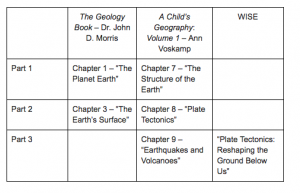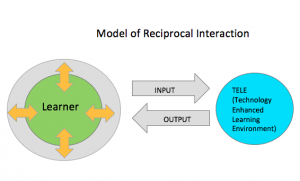The following posting is guided by the following process questions:
-
What broader questions about learning and technology have provoked WISE research and the development of SKI?
-
Describe the authors’ pedagogical design considerations that shaped the development of “What’s on your Plate?” How and where was WISE integrated into a larger sequence of activities?
-
Analyze the evidence and author’s conclusions. Are the conclusions justified? In what ways does WISE support the processes commonly associated with “inquiry” in science? How might these processes be used to support math instruction?
-
What might be the cognitive and social affordances of the WISE TELE for students? Use “What’s on your Plate?” as an example to support your hypotheses.
Inquiry is the newest trend in pedagogical design and curriculum and infiltrates BCs New Curriculum established for K-9 students. As described in the following video on the BC Ministry of Education website, inquiry requires students to ask questions, hypothesize, investigate, experiment, create, reflect and revise. These actions are intended to help students to learn the processes of science, and not solely the content, while building skills in communication, collaboration, critical thinking, vocabulary building and analysis.
Linn, Clark and Slotta (2003) offer a deeper definition of inquiry and describe it as “engaging students in the intentional process of diagnosing problems, critiquing experiments, distinguishing alternatives, planning investigations, revising views, researching conjectures, searching for information, constructing models, debating with peers, communicating to diverse audiences, and forming coherent arguments (p.518). The designers of WISE (Web-based Inquiry Science Environment) have taken this latter definition, placed it into the Scaffolded Knowledge Integration network (SKI), while asking questions of how to design a technology-based learning environment that “scaffold[s] designers in creating inquiry curriculum projects and designing patterns of activities to promote knowledge integration for students and teachers” (Linn et al., 2003, p.518). The designing of WISE is an evolving inquiry as the design team, including science teachers, pedagogical specialists, scientists and technology designers, engage in inquiry processes through its continuous designing and revising. The designers of WISE are not simply interested in inquiry, but in the intersection of inquiry and technology and the enhancement of learning as a result. A considerable statistic cited by Linn et al. (2003) describing the participation level of students through asynchronous communication in comparison to face-to-face discussion is convincing: “Online asynchronous discussions enable students to make their ideas visible and inspectable by their teachers and peers and give students sufficient time to reflect before making contributions. Hsi (1997) reports that under these circumstances, students warrant their assertions with two or more pieces of evidence and over ninety percent of the students participate. In contrast, Hsi observed that only about 15% of the students participate in a typical class discussion, and that few statements are warranted by evidence” (p.530). Other WISE related studies also reveal enhanced learning as a result of students learning through a technology-based environment. One such design study is conducted by Gobert, Snyder and Houghton (2002) using a WISE project entitled, “What’s on your Plate” – a geology focussed project.
Gobert et al. (2002) pursue a design study “to investigate the impact of decisions about curricular materials with the express goal of redesigning them in accordance with the findings obtained” (p.7). More specifically, they ask, “[I]n what ways does model-building, learning with dynamic runnable visual models in WISE, and the process of critiquing peer’s models promote a deeper understanding of the nature of science as a dynamic process?” (p.7). The two areas of SKI that are focussed on in this study are: 1) making thinking visible and 2) learning from others. Gobert et al.(2002) are also interested in observing changes in students’ epistemologies as they work through the WISE project. Specifically, they asked these questions: “How can we use the technology effectively to promote deep learning in line with epistemic goals? and How can we identify change in students’ epistemic understanding?” (p.2). In order to measure these epistemic changes, pre and post tests are conducted indicating significant increases in student understanding and reasoning related to model-based learning. Student post test responses include significantly more detail, scientific vocabulary and accurate knowledge, while peer critiques include reasoning and communicative understanding. Gobert et al. (2002) state established research for integrating model-based learning within science education, both models to learn from and model construction assignments. Positive effects of model-based learning integration are described here: “It is believed that having students construct and work with their own models engages them in authentic scientific inquiry, and that such activities promote scientific literacy, understanding of the nature of science, and lifelong learning” (Gobert et al., 2002, p.3). These positive effects of model-based learning are evidenced in the conclusions of the design study by Gobert et al. (2002). While model-based learning through WISE indicates significant growth in the students’ understanding of the use of dynamic visual models and the nature of science, can this model-based learning also be effective in the acquisition of mathematics?
WISE supports the processes of inquiry through the “What’s on Your Plate” project including diagnosing, planning, researching, constructing, critiquing, revising, communicating and reasoning. Through these inquiry processes, students successfully make their thinking visible through the construction of models which are then critiqued by peers, and then revised through reasoning. Model-based learning in mathematics could be structured similarly using inquiry processes that require students to diagnose a problem, research the information necessary to solve the problem, construct a model using software or hands-on materials, and share their model with an explanation for peer critique. {This process is evident in The Jasper Series.} Reasoning and further research follow the critique leading to a revised model construction. In essence, model-based learning affords the student to become a “teacher” through the construction of a teachable model. In mathematics, model-based learning could predictably enhance understanding in areas of geometry, patterning and problem solving. Models could include simulations, diagram representations, symbolic data, or three-dimensional constructions.
After brief research, this following resource seems valuable in inquiring further into model-based learning: Model-Based Approaches to Learning: Using Systems Models and Simulations to Improve Understanding and Problem Solving in Complex Domains by Patrick Blumschein, Woei Hung, David Jonassen, and Johannes Stroebel (2009).

